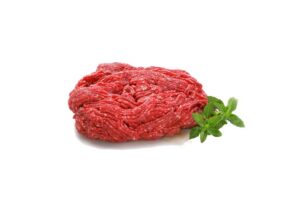About Chicken thigh :-
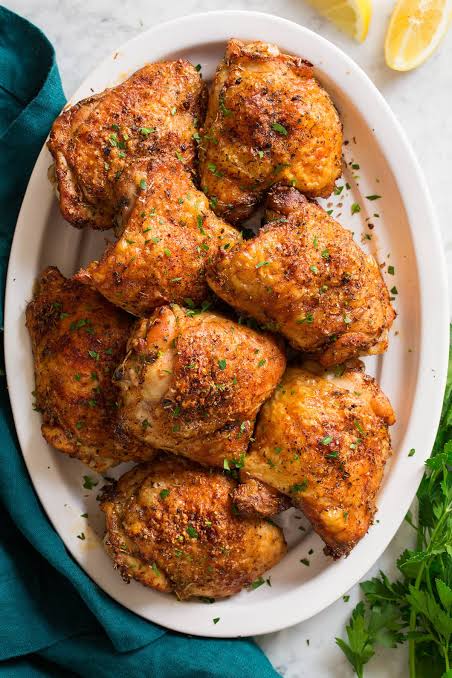
Chicken thighs refer to the upper part of a chicken’s leg, located between the drumstick and the body. They are known for being dark meat, which means they have a higher fat content than chicken breasts, making them juicier and more flavorful.
key characteristics:-
1. Dark Meat
- Chicken thighs are considered dark meat due to their higher myoglobin content, giving them a darker color and richer flavor compared to white meat like chicken breasts.
2. Higher Fat Content
- Thighs have a higher fat content, which makes them juicier and more flavorful. The fat also helps prevent the meat from drying out during cooking.
3. Tender Texture
- The meat is more tender and moist than chicken breasts, especially when cooked properly. Even after prolonged cooking, chicken thighs remain juicy.
4. Flavor
- Due to their fat and dark meat composition, chicken thighs have a richer, more intense flavor compared to the milder taste of chicken breasts.
5. Versatile Cooking Methods
- Chicken thighs are very versatile and work well with a variety of cooking methods, including baking, grilling, frying, braising, and stewing. They retain their moisture well, making them ideal for slow cooking and high-heat methods.
6. Bone-In vs. Boneless
- Chicken thighs can be found bone-in (adds flavor during cooking) or boneless (for quicker cooking and easier preparation).
7. Skin-On vs. Skinless
- You can purchase chicken thighs with the skin on, which adds crispiness when cooked, or skinless for a leaner option. The skin also helps retain moisture during cooking.
8. Nutritional Profile
- Chicken thighs are higher in fat and calories than chicken breasts, but they are also a good source of protein and contain important nutrients like iron, zinc, and B vitamins.
9. Affordable
- Chicken thighs are generally more affordable than chicken breasts, making them a cost-effective option for flavorful and nutritious meals.
10. Cooking Time
- Chicken thighs, especially bone-in, often take longer to cook compared to boneless breasts, but the extra cooking time enhances their flavor and tenderness.
Why we love chicken thigh:-
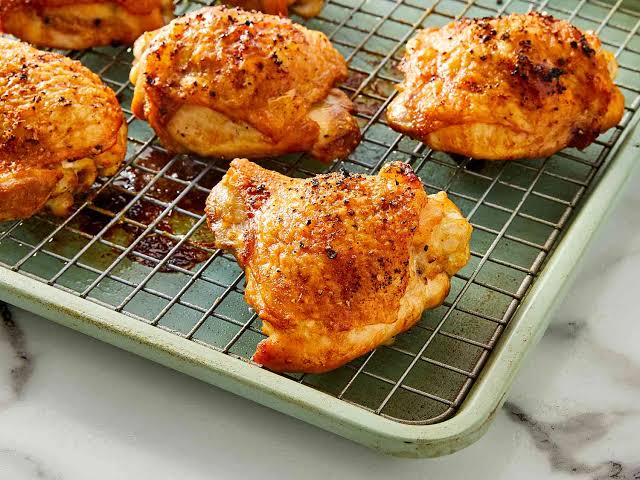
There are several reasons why chicken thighs are loved by many, from their flavor to their versatility in cooking. Here’s why chicken thighs are so popular:
1. Rich Flavor
- Chicken thighs are part of the dark meat portion of the chicken, which gives them a richer, more savory flavor compared to the leaner and milder-tasting chicken breasts. The higher fat content contributes to this robust taste, making them more flavorful.
2. Juicy and Tender
- Due to their higher fat content, chicken thighs remain moist and tender even after cooking, unlike chicken breasts, which can dry out more easily. The fat keeps the meat juicy, making every bite more enjoyable.
3. Versatility
- Chicken thighs are incredibly versatile. They can be baked, grilled, fried, braised, or slow-cooked in stews and curries. Whether you want to prepare a quick meal or a slow-cooked dish, chicken thighs adapt well to different cooking methods and cuisines.
4. Cost-Effective
- Chicken thighs are typically cheaper than chicken breasts, offering a more affordable option for delicious meals. Their price makes them a favorite for feeding families or cooking in bulk without sacrificing flavor.
5. Perfect for Long Cooking
- Unlike chicken breasts, which can dry out during long cooking, chicken thighs retain their moisture and become even more tender and flavorful over time. This makes them ideal for braising, stewing, or slow-cooking.
6. Bone-In and Skin-On Options
- The bone-in, skin-on varieties add extra flavor and crispiness to dishes. The bones contribute flavor to the meat, and the skin, when cooked properly, becomes crispy and delicious, adding an extra layer of texture and taste.
7. Nutrient-Rich
- Chicken thighs provide essential nutrients like iron, zinc, and B vitamins, which are important for energy metabolism and overall health. While slightly higher in fat, they still offer a good source of high-quality protein.
8. Hard to Overcook
- Chicken thighs are more forgiving in the kitchen, meaning they are less likely to dry out if slightly overcooked. This makes them a reliable option for beginner cooks and ensures they remain tender and juicy.
9. Great for Marinades
- Chicken thighs absorb marinades exceptionally well due to their higher fat content, making them a perfect choice for dishes that rely on strong, bold flavors. They hold onto spices, sauces, and seasonings better than leaner cuts.
10. Global Appeal
- Chicken thighs are used in a variety of global cuisines. From curries and stews to BBQ and roasts, they are loved in many cultures for their ability to take on flavors from a range of spices and herbs.
Main ingradient for making making chicken thigh:-

To make flavorful chicken thighs, the main ingredients typically include the chicken thighs themselves, along with a few basic seasonings and ingredients for marination or flavor enhancement.
- Chicken Thighs:
- The star of the dish. You can use bone-in, skin-on or boneless, skinless thighs, depending on the recipe and desired texture.
- Oil (optional but common):
- Olive oil, vegetable oil, or butter is often used for marinating or cooking the chicken thighs to keep them moist and help with browning and crisping the skin.
- Salt:
- Essential for seasoning and bringing out the natural flavor of the chicken.
- Pepper:
- Black pepper or other types of pepper add a touch of spice and balance the seasoning.
Additional Flavor Enhancers (Optional but Common):
- Garlic (fresh or powder):
- Adds depth of flavor and a savory note to the dish.
- Herbs:
- Common herbs include thyme, rosemary, oregano, parsley, or cilantro. These herbs can be used fresh or dried to add fragrance and herbaceous flavor.
- Spices:
- Paprika, cumin, chili powder, or cayenne pepper can be used to create a richer, spicier flavor.
- Lemon Juice or Vinegar:
- A splash of lemon juice or vinegar in the marinade can add a tangy flavor and help tenderize the meat.
- Soy Sauce or Worcestershire Sauce:
- Often used in marinades for a savory umami boost.
- Honey or Brown Sugar:
- Used in some recipes to create a sweet and sticky glaze or to balance spicy flavors.
Optional Marinade Ingredients:
- Yogurt or Buttermilk: These can be used to tenderize the chicken.
- Mustard or BBQ Sauce: Great for basting or creating a flavorful coating.
Recipe of chicken Thigh:-
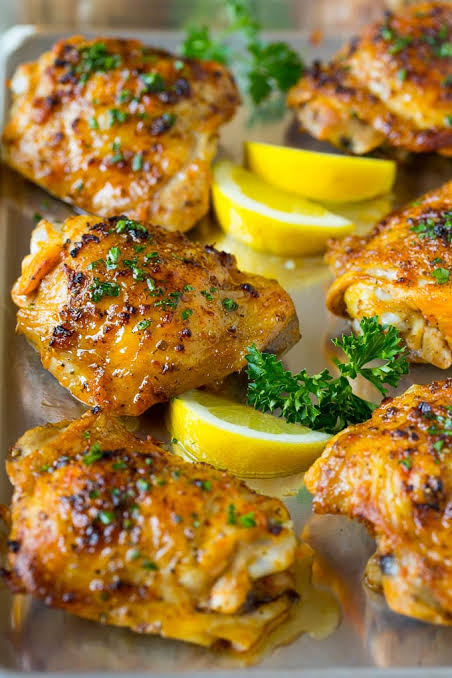
Here’s a basic recipe for baked chicken thighs, with ingredients measured in grams:
Ingredients:
- Chicken thighs (bone-in, skin-on or boneless, skinless): 4 pieces (about 500-600g)
- Olive oil: 30g (about 2 tablespoons)
- Garlic (minced): 10g (2-3 cloves)
- Lemon juice: 15g (about 1 tablespoon)
- Salt: 5g (about 1 teaspoon)
- Black pepper: 2g (about ½ teaspoon)
- Paprika: 5g (about 1 teaspoon)
- Fresh herbs (rosemary, thyme, or parsley): 10g (optional)
- Honey or brown sugar: 10g (optional, for a touch of sweetness)
Instructions:
- Preheat the oven:
- Preheat your oven to 200°C (400°F).
- Prepare the marinade:
- In a small bowl, mix together olive oil (30g), minced garlic (10g), lemon juice (15g), salt (5g), black pepper (2g), paprika (5g), and fresh herbs (if using).
- Coat the chicken thighs:
- Rub the marinade all over the chicken thighs (500-600g), ensuring they are evenly coated. If you have time, let the chicken marinate in the refrigerator for 30 minutes to 2 hours for better flavor absorption.
- Bake the chicken:
- Place the marinated chicken thighs on a baking sheet lined with parchment paper or a lightly greased baking dish. If using bone-in, skin-on thighs, place them skin-side up to get a crispy finish.
- Optionally, drizzle honey or sprinkle brown sugar (10g) on top for a caramelized finish.
- Cook the chicken:
- Bake in the preheated oven for 35-40 minutes (for bone-in) or 25-30 minutes (for boneless), until the chicken reaches an internal temperature of 75°C (165°F), and the skin is golden and crispy.
- Rest and serve:
- Let the chicken rest for about 5 minutes before serving to allow the juices to redistribute.
Tips:
- You can add vegetables like potatoes, carrots, or zucchini to the baking dish for a complete meal.
- If you want extra crispy skin, broil the chicken for the last 3-5 minutes of baking.
Advantage of eating chicken thigh:-
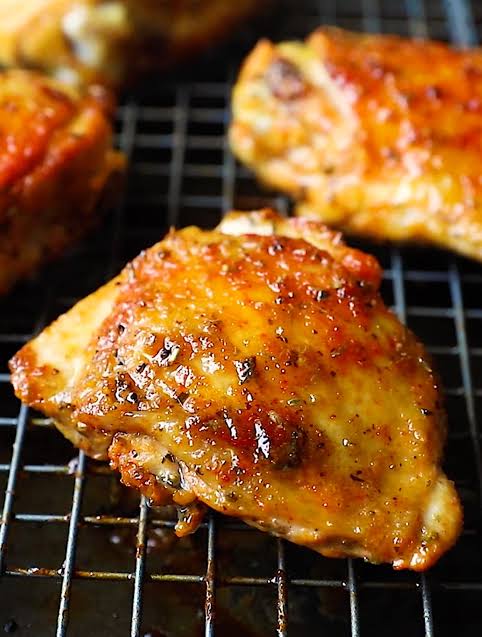
Eating chicken thighs offers several advantages, both nutritionally and in terms of flavor. Here are the key benefits:
1. Rich in Protein
- Chicken thighs are a good source of high-quality protein, which is essential for muscle repair, growth, and overall body maintenance. A serving provides about 20-25g of protein, depending on the portion size.
2. Rich in Vitamins and Minerals
- Chicken thighs contain important nutrients, including:
- Iron: Supports healthy red blood cells and oxygen transport.
- Zinc: Boosts the immune system and helps with cell repair.
- B Vitamins (especially B6 and B12): Support metabolism, brain function, and energy production.
3. Higher Fat Content for Satiety
- The higher fat content in chicken thighs (compared to breasts) provides longer-lasting satiety, making you feel full for a longer time. This can be helpful for managing hunger and potentially reducing overall calorie intake throughout the day.
4. Moisture and Tenderness
- Chicken thighs are known for being moist and tender, especially after cooking. This makes them more enjoyable to eat and less prone to becoming dry compared to leaner cuts like chicken breasts.
5. Flavorful
- The extra fat content in chicken thighs contributes to their richer, more robust flavor, which enhances the taste of many dishes without the need for excessive seasoning or sauces.
6. Affordable
- Chicken thighs are generally more affordable than chicken breasts or other cuts of meat, making them a cost-effective source of protein for families and those on a budget.
7. Versatility in Cooking
- Chicken thighs can be prepared in a variety of ways—grilled, baked, braised, fried, or used in stews and curries. They are more forgiving when it comes to cooking methods, as they retain moisture even after extended cooking.
8. Rich in Healthy Fats (Especially in Skin)
- If consumed with the skin, chicken thighs offer some beneficial fats, including monounsaturated fats, which can be good for heart health when eaten in moderation.
9. Good for Bone Health (Bone-In Thighs)
- When you cook bone-in chicken thighs, the bones add calcium, phosphorus, and collagen to your diet, which can help support bone health and joint function.
10. Provides Energy
- The fat and protein in chicken thighs provide sustained energy, making them a great meal choice for those needing fuel for physical activities or long workdays.
Summary:
Eating chicken thighs offers a balance of protein, vitamins, and healthy fats, making them a nutritious and flavorful choice. Their moisture, flavor, and affordability make them a popular option for people who enjoy richer, more satisfying meals.
Disadvantage of eating chicken thigh:-

While chicken thighs are a flavorful and nutritious part of the chicken, there are some potential disadvantages, especially when consumed in large quantities or when prepared in certain ways. Here are the key points:
1. Higher Fat and Calorie Content
- Chicken thighs contain more fat and calories compared to leaner cuts like chicken breasts. The fat content is mostly saturated fat, which can contribute to weight gain and may raise cholesterol levels if consumed in excess.
- Example: A 100g serving of chicken thighs (skin-on) contains about 11-15 grams of fat and 200-250 calories, whereas chicken breasts contain about 3-4 grams of fat and 150 calories.
2. Saturated Fat
- The higher amount of saturated fat in chicken thighs, especially when eaten with the skin, may increase the risk of heart disease if consumed frequently and in large amounts. A diet high in saturated fats is linked to increased LDL (bad cholesterol) levels.
3. Risk of Overeating
- Due to their rich flavor and juiciness, chicken thighs can be easy to overeat, which can lead to excessive calorie and fat consumption, especially in high-fat cooking methods like frying or with creamy sauces.
4. Preparation Methods
- Chicken thighs are often prepared using methods that add extra fat and calories, such as frying or using rich sauces. Cooking methods like deep-frying or using heavy marinades can make the dish more unhealthy and lead to weight gain and other health issues.
- Example: A fried chicken thigh may contain significantly more calories due to the added oil or batter.
5. Potential for High Sodium
- Pre-seasoned or pre-marinated chicken thighs, as well as those cooked in processed sauces or gravies, can be high in sodium. Excessive sodium intake is associated with high blood pressure and can increase the risk of cardiovascular diseases.
6. Not Ideal for Low-Fat Diets
- People on low-fat or heart-healthy diets may need to limit their consumption of chicken thighs due to the higher fat content compared to other cuts like chicken breasts or lean meats. For those looking to control fat intake, chicken thighs might not be the best choice.
7. Risk of Overcooking Boneless Thighs
- Although chicken thighs are generally more forgiving than chicken breasts, boneless, skinless thighs can still become dry and less tender if overcooked, especially if they’re cooked at too high a temperature for too long.
8. Bone-In Thighs Require More Care
- Bone-in chicken thighs can be trickier to cook properly compared to boneless cuts. The meat around the bone can take longer to cook, and if not cooked thoroughly, it can pose a risk of undercooked meat, which carries a higher chance of foodborne illnesses like salmonella.
Nutrition value of chicken thigh:-

The nutritional value of chicken thighs can vary depending on whether they are skin-on or skinless, bone-in or boneless, and how they are cooked. Below is an approximate breakdown of the nutrition for 100 grams of cooked chicken thigh, both with and without skin.
Nutritional Value of Chicken Thigh (100g, Cooked)
1. Chicken Thigh (Skinless, Boneless, Cooked)
- Calories: 209 kcal
- Protein: 26 grams
- Fat: 10.9 grams
- Saturated Fat: 3 grams
- Monounsaturated Fat: 4 grams
- Polyunsaturated Fat: 2.3 grams
- Cholesterol: 113 mg
- Sodium: 82 mg
- Iron: 0.9 mg
- Potassium: 240 mg
- Phosphorus: 178 mg
- Vitamin B6: 0.5 mg (26% of daily value)
- Niacin (Vitamin B3): 5.5 mg (28% of daily value)
2. Chicken Thigh (Skin-On, Bone-In, Cooked)
- Calories: 250 kcal
- Protein: 21 grams
- Fat: 19 grams
- Saturated Fat: 5.3 grams
- Monounsaturated Fat: 7 grams
- Polyunsaturated Fat: 3.3 grams
- Cholesterol: 125 mg
- Sodium: 90 mg
- Iron: 1.1 mg
- Potassium: 226 mg
- Phosphorus: 165 mg
- Vitamin B6: 0.3 mg (17% of daily value)
- Niacin (Vitamin B3): 4.8 mg (24% of daily value)
Key Nutritional Aspects:
- High in Protein: Chicken thighs provide a good source of high-quality protein, which is essential for muscle repair, growth, and overall health.
- Moderate in Calories: Chicken thighs, especially with the skin on, are more calorie-dense than chicken breasts due to the higher fat content.
- Higher in Fat: Chicken thighs have more fat, especially saturated fat, which can increase total calorie intake. However, they also contain healthy fats like monounsaturated and polyunsaturated fats.
- Rich in B Vitamins: Chicken thighs are a good source of vitamins B6 and niacin, which help support metabolism and energy production.
- Contains Iron and Phosphorus: Chicken thighs provide important minerals like iron (important for oxygen transport in the blood) and phosphorus (vital for bone health).
Summary:
Chicken thighs are a nutritious source of protein, though they are higher in fat and calories compared to leaner cuts like chicken breasts. Skinless thighs offer a lower-fat option, while keeping the skin increases fat content but also adds flavor and moisture. Chicken thighs are rich in B vitamins, iron, and essential minerals.
What are chicken thighs?
Chicken thighs are the upper part of the chicken’s leg, located between the drumstick and the body. They are considered dark meat, which has more fat and a richer flavor compared to white meat.
Are chicken thighs healthy?
Yes, chicken thighs are a good source of protein, iron, and B vitamins. However, they are higher in fat and calories compared to chicken breasts. Choosing skinless thighs or removing the skin can reduce fat content and make them healthier.
How should I cook chicken thighs?
Chicken thighs can be baked, grilled, fried, braised, or slow-cooked. Cooking methods can affect their fat content and texture. Baking or grilling with a marinade can enhance flavor while keeping them relatively healthy.
Read this also:– margharita recipe Mac and cheese recipe
carrot cake recipe banana pudding
-
chicken thigh| chicken thigh recipes | tasty and delicious
About Chicken thigh :- Chicken thighs refer to the upper part of a chicken’s leg, located between the drumstick and the body. They are known for being dark meat, which means they have a higher fat content than chicken breasts, making them juicier and more flavorful. key characteristics:- 1. Dark Meat 2. Higher Fat Content
-
Old fashioned| mocktail| old fashioned mocktail recipe
About Old fashioned:- The Old Fashioned is a classic cocktail that dates back to the early 19th century and is known for its simplicity and strong flavor profile. It’s typically made with whiskey, sugar, bitters, and a citrus peel, often served over a large ice cube in a lowball glass. Why we love old fashioned
-
Margarita recipe | how to make | margarita mocktail | amazing cocktail
About margarita:- A margarita is a popular cocktail that originated in Mexico, known for its refreshing and tangy flavor profile. It is typically made with tequila, lime juice, and an orange liqueur like Cointreau or Triple Sec, and is often served in a glass with a salted rim. Margaritas can be enjoyed on the rocks
-
Mac and cheese recipe | baked mac and cheese recipe| best mac and cheese recipe|
About mac and cheese :- Mac and Cheese, short for macaroni and cheese, is a classic comfort food beloved by many across the world. This dish typically consists of cooked elbow macaroni pasta combined with a creamy cheese sauce. While simple in its basic form, mac and cheese has endless variations, from stovetop versions to
-
Ground beef| ground beef recipes | how to make | tasty and juicy
About ground beef:- Ground beef is beef that has been finely chopped or minced, making it versatile and suitable for various recipes. It’s commonly used in dishes like burgers, meatballs, tacos, and spaghetti sauce. Here’s a detailed look at ground beef: why we love ground beef:- Ground beef is a popular ingredient for several reasons,
